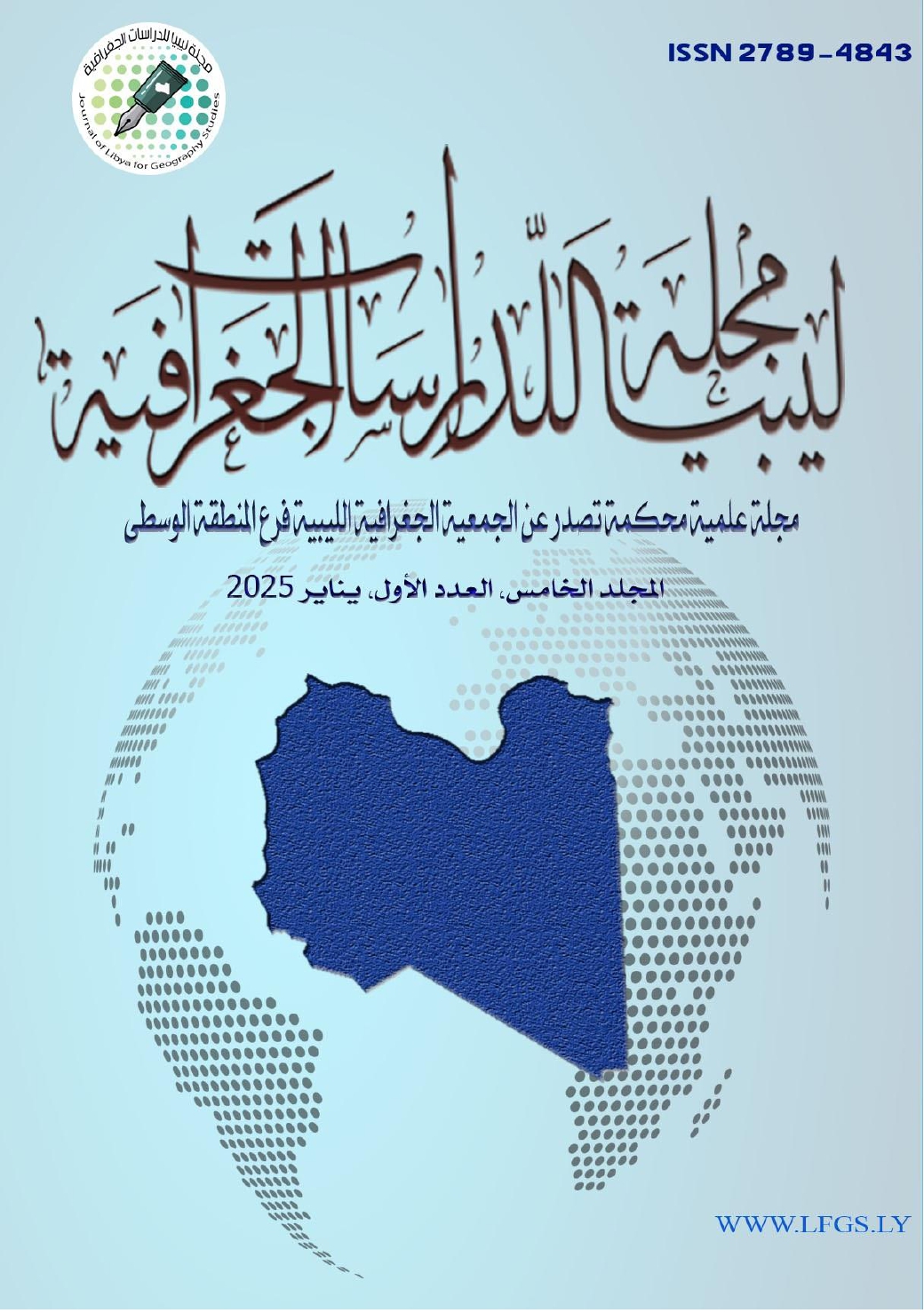القشرة البيولوجية للتربة في حوض وادي الرام باستخدام تقنية الاستشعار عن بعد دراسة في جغرافية البيئة
DOI:
https://doi.org/10.37375/jlgs.v5i1.3110الكلمات المفتاحية:
التربة، القشرة البيولوجية للتربة، حوض وادي الرام، الاستشعار عن بعدالملخص
يُعَدُّ تتبع وجود القشرة البيولوجية في التربة وتغير توزيعها مكانياً وزمانياً من الأمور المهمة في إدارة الأنظمة البيئية في المناطق الصحراوية، ويوفر معلومات ذات أهمية للغاية عن دراسة التصحر وتغير المناخ في البيئات الجافة، وبذلك تهدف الدراسة إلى كشف توزيع وتغير نمط توزيع القشرة البيولوجية للتربة في حوض وادي الرام باستخدام تقنية الاستشعار عن بعد، وتوصلت نتائج الدراسة إلى أن مساحة المنطقة التي تتصف بكثافة القشرة البيولوجية تغيرت بالموجب في مختلف الفترات، ومما يؤكد ذلك زيادة مساحة المنطقة التي تتصف بكثافة القشرة البيولوجية للتربة بنحو 33.3 كم2 بين عامي 2000 - 1990، وازدادت مساحة هذه المنطقة بنحو 42.1 كم2 بين عامي 2000 - 2018.
المراجع
- الزايط، نفيسة، ومحمد، عبدالرحمن: (2016)، القشرة الحية للتربة بهضبة الجبل الأخضر: أنماطها ودورها في استعمالات الأرض الزراعية، مجلة العلوم والدراسات الإنسانية، جامعة بنغازي، العدد، 11.
- الغامدي، سعد أبو رأس: (2008)، مراقبة التصحر في أجزاء من غرب المملكة باستخدام تقنية الاستشعار عن بعد، مجلة جامعة الملك سعود للعلوم الزراعية، المجلد، 20.
- Alonso.M, Rodríguez.C.E, Chamizo.S, Escribano.P, Cantón.Y: (2014), Evaluation of the different spectral indices to map biocrust using spectral information, Revista de teledetección Asociación Española de Teledetección, Vol, 42, pp.79-98.
- Belnap.J, Kaltenecker.J.K, Rosentreter.R, Williams.J, Leonard.S, Eldridge.D: (2001), Biological Soil Crusts: Ecology and Management, U.S. Department of the Interior Bureau of Land Management U.S. Geological Survey.
- Belnap.J, Weber.B, Budel.B:(2016), Biological Soil Crusts as an Organizing Principle in Drylands, Ecological Studies, Vol,226, pp.3-13.
- Bu.C, WU.S, Xie.Y, Zhang.X: (2013), The Study of Biological Soil Crusts: Hotspots and Prospects, Clean soil air water, Vol,41, Iss,9, pp.899-906.
- Caballero.E.R, Cantón.Y, Chamizo.S, Afana.A, Benet.A.S: (2012), Effects of biological soil crusts on surface roughness and implications for runoff and erosion, Geomorphology, Vol, 145–146, PP. 81-89.
- Chamizo.S, Cantón.Y, Miralles.I, Domingo.F: (2012), Biological soil crust development affects physicochemical characteristics of soil surface in semiarid ecosystems, Soil Biology & Biochemistry, Vol, 49,pp. 96-105.
- Chen.J, Zhang.M.Y, Wang.L, Shimazaki.H, Tamura.M: (2005), A new index for mapping lichen-dominated biological soil crusts in desert areas, Remote Sensing of Environment, Vol, 96, pp.165 – 175.
- Dody.A, Hakmon.R, Asaf.B, Zaady.E: (2011), Indices to monitor biological soil crust growth rate—lab and field experiments, Natural Science, Vol.3, No.6, pp. 478-483.
- Karnieli.A, Kokaly.R.F, Wese.N.E, Clark.R.N: (2001), Remote Sensing of Biological Soil Crusts, Ecological studies, Vol, 150, pp. 431-455.
- Lehnert.L.W, Jung.P, Obermeier.W.A, Budel.B: (2018), Estimating Net Photosynthesis of Biological Soil Crusts in the Atacama Using Hyperspectral Remote Sensing, Remote Sens, Vol, 10,pp.1-17.
- Miller.S, Warren.S, Clair.L.S: (2017), Don’t Bust the Biological Soil Crust: Preserving and Restoring an Important Desert Resource, United States Department of Agriculture, January/ February 2017 | Issue 23.
- Moghtaderi.A, Moore. F, Taghavi, S, Rezaei. R: (2011), The application of ASTER imageries and mathematical evaluation method in detecting cyanobacteria in biological soil crust, Chadormalu area, central Iran. Iran. J. Sci. Technol. 1, 13-28.
- Rosas.J.V, Vargas.J.G.P, Maya.Y:(2014), Microarthropod communities related with biological soil crusts in a desert scrub in northwestern Mexico, Revista Mexicana de Biodiversidad, Vol, 85,pp. 513-522.
- Rozenstein. O, Karnieli.A: (2015), Identification and characterization of Biological Soil Crusts in a sand dune desert environment across IsraeleEgypt border using LWIR emittance spectroscopy,Journal of Arid Environments,Vol,112, pp. 75-86.
- Song.G, Li.X, Hui.R: (2014), Biological soil crusts determine the germination and growth of two exotic plants, Ecol Evol. Vol. 7(22).
- Panah.S.K.A, Damavandi.A, Rezaei.A, Hamzeh.S:(2016), Remote sensing application in evaluation of soil characteristics in desert areas, Natural Environment Change, Vol, 2, pp.1-24.
- Pointing.S.B, Belnap.j: (2012), Microbial colonization and controls in dryland systems, Nature Reviews Microbiology, Vol, 10, pp.551-562.
- Pichel.F.G, Johnson.S.L, Youngkin.D, Belnap.J: (2003), Small-Scale Vertical Distribution of Bacterial Biomass and Diversity in Biological Soil Crusts from Arid Lands in the Colorado Plateau, Microbial Ecology, Vol 46, pp 312–321.
- USGS, Landsat satellite images (5, 8), accessed on (6/15/2018), (https://earthexplorer.usgs.gov/).
- USGS, Digital Elevation Model, (SRTM), accessed on (6/15/2018), (https://earthexplorer.usgs.gov/).
- Ustin.S.L, Santos.M.J, Kefauver.S.C, Whiting.M.L, Remote Sensing of biological soil crust under simulated change, https: //www.researchgate.net/publication/229042040.
- Yuanming.Z, Jin.C,Xueqin.W, Huixia.P, Zhihui.G, Borong. P: (2005), The Distribution Patterns of Biological Soil Crust in Gurbantunggut Desert, Acta Geographica Sinica, Vol, 60, Issue, (1), pp. 53-60.
- Weber.B, Olehowski.C, Knerr.T, Hill.J: (2008), A new approach for mapping of Biological Soil Crusts in semidesert areas with hyperspectral imagery, Remote Sensing of Environment, Vol, 112 (5), pp.2187-2201.
- Zhang. Y. N., Chen. j., Wang. L., Wang, X. Q., Gu, Z. H: (2007), The spatial distribution patterns of biological soil crusts in the Gurbantunggut Desert, Northern Xinjiang, China, Journal of Arid Environments, Vol, 68,pp. 599–610.














